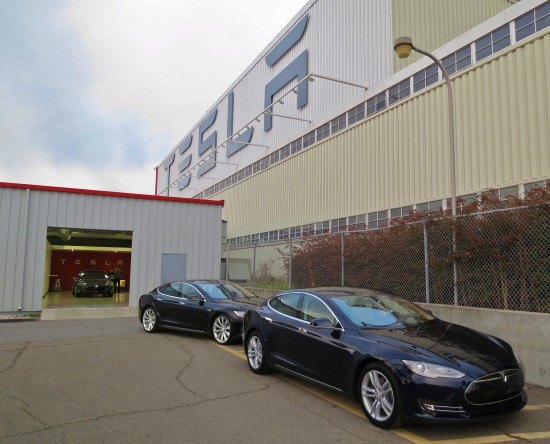Tesla's Q4 Results Raise Questions About Long-Term Future
Tesla Motors Inc. released its Fourth Quarter & Full Year 2012 Shareholder letter on Wednesday. While the letter provides a very positive outlook for Tesla’s future, there are some questions looming in the background once we dig deeper into Tesla’s balance sheet.
Despite supply chain issues, Tesla has apparently achieved their stated goal of producing 400 cars per week at their Fremont, California factory. Tesla hopes to capitalize on its new found production ability, an annualized rate of 20 000 units per year, to take the Model S into Europe and Asia. However, there is still no indication whether Tesla will be reporting their sales figures in the United States like other auto makers do.
When viewed in isolation, Q4 has undeniably been one of the most successful sales periods for Tesla. 74% of Tesla’s overall revenues were recognized in Q4 alone, and reported sales growth from Q3 to Q4 was over 500%. But Tesla’s broader financial health isn’t nearly as rosy. The firm’s Q4 loss is reported at almost $90 million or $0.79 on a per share basis. Tesla’s net loss this year is almost $400 million, or $3.69 per share. Despite the fact that Tesla has slowly been improving its operating margin, which currently is at 8%, Tesla has not been able to carve enough contribution out of its sales to help cover its staggering Research and Sales expenses.
These costs combined make up 103% of Tesla’s overall revenues. Despite the fact that Tesla estimates a 15% reduction in its R&D costs for 2013, it is still fighting an uphill battle. Expansion into Europe and Asia will also require more retail and marketing resources, which will only further add to Tesla’s profitability woes.
At this time, Tesla remains highly leveraged, with a debt to equity ratio of 3.62. With some $450 million in long term debt sitting on its books (and nearly $1 billion in total liabilities), and no earnings to repay it with, Tesla’s future stability is questionable. While it does have approximately $200 million cash on hand, between a negative cash conversion cycle of 46 days and interest payments on the debt, not to mention negative free cash flow of over $500 million, one can only wonder how long until the well runs dry. Despite Tesla’s stated “cash flow positive” status in Q1 2013, this is using non-GAAP figures.
Hope still remains for the zero emissions car manufacturer as it looks to achieve economies of scale and reduce its fixed costs through improved production efficiencies. The projected increase in volume will also help towards the bottom line.
N.B: GAAP Figures used
Graeme Kreindler is an HBA Candidate at the Richard Ivey School of Business at The University of Western Ontario.
More by Graeme Kreindler
Latest Car Reviews
Read moreLatest Product Reviews
Read moreRecent Comments
- Lichtronamo Watch as the non-us based automakers shift more production to Mexico in the future.
- 28-Cars-Later " Electrek recently dug around in Tesla’s online parts catalog and found that the windshield costs a whopping $1,900 to replace.To be fair, that’s around what a Mercedes S-Class or Rivian windshield costs, but the Tesla’s glass is unique because of its shape. It’s also worth noting that most insurance plans have glass replacement options that can make the repair a low- or zero-cost issue. "Now I understand why my insurance is so high despite no claims for years and about 7,500 annual miles between three cars.
- AMcA My theory is that that when the Big 3 gave away the store to the UAW in the last contract, there was a side deal in which the UAW promised to go after the non-organized transplant plants. Even the UAW understands that if the wage differential gets too high it's gonna kill the golden goose.
- MKizzy Why else does range matter? Because in the EV advocate's dream scenario of a post-ICE future, the average multi-car household will find itself with more EVs in their garages and driveways than places to plug them in or the capacity to charge then all at once without significant electrical upgrades. Unless each vehicle has enough range to allow for multiple days without plugging in, fighting over charging access in multi-EV households will be right up there with finances for causes of domestic strife.
- 28-Cars-Later WSJ blurb in Think or Swim:Workers at Volkswagen's Tennessee factory voted to join the United Auto Workers, marking a historic win for the 89- year-old union that is seeking to expand where it has struggled before, with foreign-owned factories in the South.The vote is a breakthrough for the UAW, whose membership has shrunk by about three-quarters since the 1970s, to less than 400,000 workers last year.UAW leaders have hitched their growth ambitions to organizing nonunion auto factories, many of which are in southern states where the Detroit-based labor group has failed several times and antiunion sentiment abounds."People are ready for change," said Kelcey Smith, 48, who has worked in the VW plant's paint shop for about a year, after leaving his job at an Amazon.com warehouse in town. "We look forward to making history and bringing change throughout the entire South." ...Start the clock on a Chattanooga shutdown.


































Comments
Join the conversation
I would like to see Tesla divulge their production and sales numbers, rather than plant capacity. Not doing so is shady.
Hi-effen-larious. Tesla's future has never been in doubt-it will never make money. Period. Full stop. It's not 'BK and gone' because of a pile of investor cash. Everybody with a clue knew that when the latest Musk cash burner was allowed to flame, there'd be idiots. And here they are. It's more negative than the last GM - any moron who can actually read a spreadsheet knew that 5 years ago. Musk isn't capable of running a taco stand.